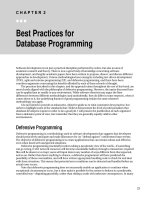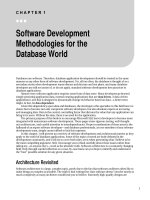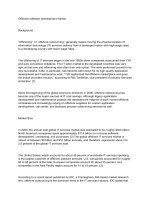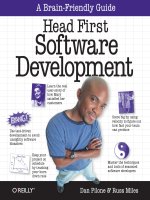Software Development Rhythms: Harmonizing Agile Practices for Synergy ppt
Bạn đang xem bản rút gọn của tài liệu. Xem và tải ngay bản đầy đủ của tài liệu tại đây (4.51 MB, 325 trang )
www.it-ebooks.info
www.it-ebooks.info
SOFTWARE DEVELOPMENT
RHYTHMS
www.it-ebooks.info
www.it-ebooks.info
SOFTWARE DEVELOPMENT
RHYTHMS
Harmonizing Agile
Practices for Synergy
Kim Man Lui and Keith C. C. Chan
The Hong Kong Polytechnic University, Hong Kong
A JOHN WILEY & SONS, INC., PUBLICATION
www.it-ebooks.info
Copyright Ó 2008 by John Wiley & Sons, Inc. All rights reserved.
Published by John Wiley & Sons, Inc., Hoboken, New Jersey
Published simultaneously in Canada
No part of this publication may be reproduced, stored in a retrieval system, or transmitted in any
form or by any means, electronic, mechanical, photocopying, recording, scanning, or otherwise, except
as permitted under Section 107 or 108 of the 1976 United States Copyright Act, without either the
prior written permission of the Publisher, or authorization through payment of the appropriate
per-copy fee to the Copyright Clearance Center, Inc., 222 Rosewood Drive, Danvers, MA 01923, 978-
750-8400, fax 978-750-4470, or on the web at www.copyright.com. Requests to the Publisher for
permission should be addressed to the Permissions Department, John Wiley & Sons, Inc., 111
River Street, Hoboken, NJ 07030, 201-748-6011, fax (201) 748-6008, or online at http://
www.wiley.com/go/permission.
Limit of Liability/Disclaimer of Warranty: While the publisher and author have used their best
efforts in preparing this book, they make no representations or warranties with respect to the
accuracy or completeness o f the contents of this book and specifically disclaim any implied
warranties of merchantability or fitness for a particular purpose. No warranty may b e created or
extended by sales representatives or written sales materials. The advice and strategies contained
herein may not be suitable for your situation. You should consult with a p rofessional where
appropriate. Neither the publisher nor author shall be li able for any lo ss of profit or any other
commercial damages, including but not limited to special, incidental, consequential, o r other
damages.
For general information on our other products and services or for technical support, please
contact our Customer Care Department within the United States at 800-762-2974, outside the United
States at 317-572-3993 or fax 317-572-4002.
Wiley also publishes its books in a variety of electronic formats. Some content that appears
in print may not be available in electronic formats. For more information about Wiley products,
visit our web site at www.wiley.com.
Library of Congress Cataloging-in-Publication Data:
Lui, Kim Man.
Software development rhythms : using the flexibility of agile software
practices in combination/By Kim Man Lui & Keith C.C. Chan.
p. cm.
Includes index.
ISBN 978-0-470-07386-5 (cloth)
1. Computer software – Development. I. Chan, Keith C.C. II. Title.
QA76. 76. D47L86 2007
005.1–dc22
2007019073
Printed in the United States of America
10987654321
www.it-ebooks.info
To my mother and my sister
— K.M.L
To my parents and sisters
and to Emily, Samantha, and Jeremy
— K.C.C.C.
www.it-ebooks.info
www.it-ebooks.info
CONTENTS
PREFACE xiii
1 NO PROGRAMMER DIES 3
1.1 Developing Software versus Building a Tunnel 4
1.1.1 The Good Old Days ? 5
1.1.2 The More Things Ch ange, the More They Stay the Same? 6
1.1.3 Behind Software Products 7
1.1.4 Deal or No Deal 10
1.2 Do-Re-Mi Do-Re-Mi 12
1.2.1 Iterative Models 14
1.2.2 Code and Fix 16
1.2.3 Chaos 17
1.2.4 Methodology that Matters 21
1.3 Software Development Rhythms 24
1.3.1 Stave Chart by Example 25
1.3.2 Game Theory 28
1.3.3 In–Out Diagram 30
1.3.4 Master–Coach Diagram 31
1.3.5 No Mathematics 32
1.3.6 Where to Explore Rhythms 33
References 34
2 UNDERSTANDING PROGRAMMERS 37
2.1 Personality and Intelligence 39
2.1.1 Virtuosi 40
vii
www.it-ebooks.info
2.1.2 Meeting Your Team 41
2.1.3 Recruiting Programmers 43
2.2 Outsourced Programmers 45
2.2.1 Programmers in Their Environments 46
2.2.2 Programmers, Cultures, and Teams 47
2.3 Experienced Management 48
2.3.1 Being Casual about Causal Relationships 49
2.3.2 Not Learning from Experience 50
2.3.3 Doing Things Right Right Now 52
References 54
3 START WITH OPEN SOURCE 55
3.1 Process and Practice 58
3.1.1 The Four Ps of Projects 60
3.1.2 Agile Values 63
3.1.3 Zero-Point Collaboration 64
3.2 Open-Source Software (OSS) Development 65
3.2.1 Software Cloning 66
3.2.2 Software Quality 67
3.2.3 Starting Processes 68
3.2.4 Open-Source Development Community 69
3.2.5 Ugrammers 70
3.2.6 Participant Roles 71
3.2.7 Rapid Release 72
3.2.8 Blackbox Programming 74
3.2.9 OSS Practices 76
3.3 OSS-Like Development 77
3.3.1 Agile Practices 78
3.3.2 Communication Proximity 79
3.3.3 Loose and Tight Couples 80
3.3.4 Collocated Software Development 81
3.4 Conclusion 82
References 83
4 PLAGIARISM PROGRAMMING 87
4.1 Plagiarism 89
4.1.1 Existing Code 90
viii CONTENTS
www.it-ebooks.info
4.1.2 Social Network Analysis 91
4.1.3 Being Plagiarized 92
4.1.4 Turn Everyone into a Programmer 96
4.1.5 Pattern Language 100
4.1.6 Software Team Capability 102
4.1.7 Rough-Cut Design 105
4.1.8 Training Is Not a Solution 107
4.2 Nothing Faster than Plagiarism 107
4.2.1 Immorality 108
4.2.2 Unprecedented Code 110
4.2.3 People Network 111
4.2.4 Rhythm for Plagiarism 112
4.2.5 Plagiarism at Work 114
4.3 Business and Rhythm for Plagiarism 117
4.3.1 15-Minute Business Presentation 118
4.3.2 Marketing Research 120
4.3.3 Chatting Robot 121
4.3.4 Old Song, New Singer 125
References 129
5 PAIR PROGRAMMING 131
5.1 Art and Science 132
5.1.1 The Right Partner 133
5.1.2 Noisy Programming 134
5.1.3 Just Training 135
5.1.4 Pay to Watch 135
5.2 Two Worlds 136
5.2.1 Moneyless World 137
5.2.2 Money-Led World 139
5.2.3 Economics 140
5.2.4 Mythical Quality–Time 140
5.2.5 Elapsed Time Accelerated 141
5.2.6 Critical Path Method 142
5.2.7 Why Two, Not Three : The Antigroup Phenomenon 145
5.2.8 Software Requirements Are Puzzles 146
5.3 Programming Task Demands 148
5.3.1 2 and 4 Is 6 148
5.3.2 2 and 4 Is 4 149
5.3.3 2 and 4 Is 3 150
5.3.4 2 and 4 2 151
5.3.5 2 and 4 is Unknown 152
CONTENTS ix
www.it-ebooks.info
5.4 Pair Programming Is More than Programming 153
5.4.1 Design by Code 154
5.4.2 Pair Design 156
5.4.3 Rhythmic Pair Programming 158
5.5 Pair Programming Team Coached 161
References 162
6 REPEAT PROGRAMMING 165
6.1 Controversies in Pair Programming 167
6.1.1 Is Programming a Unique Work? 168
6.1.2 Are Three Minds Better than Two? 168
6.1.3 Unreplicable Experiments 169
6.2 Repeat Programming 170
6.2.1 Variances 175
6.2.2 Principles 176
6.2.3 Triple Programming Unproductive 177
6.3 Rhythm: Pair–Solo–Pair–Solo 179
6.3.1 Persistence 179
6.3.2 Connection 181
6.3.3 Motivation 185
6.4 An Exception that Proves Brooks’ Law 188
6.4.1 Low Morale 190
6.4.2 Communication Costs 191
6.4.3 Rhythm for Late Projects 192
References 195
7 AGILE TEAMING 197
7.1 Project Teams 200
7.1.1 Self-Organizing Teams 202
7.1.2 Teams in a Team 203
7.1.3 Project Team Composition 205
7.1.4 Team Lifecycle versus Learning Curve 206
7.2 Productivity 209
7.2.1 The Illusion of Productivity 210
7.2.2 Collective Code Ownership 210
7.2.3 Accountability, Responsibility, and Transparency 211
7.3 Problems and Problem Owners 212
7.3.1 Rhythm: Trouble–Restructuring 213
7.3.2 Teaming Principles 215
x CONTENTS
www.it-ebooks.info
7.4 Failing Projects Rescued 217
7.4.1 Project Traffic Light Reporting 219
7.4.2 A Business Case 220
7.4.3 Steering Committee Meeting 220
7.4.4 Agile Teaming in Action 222
7.5 Beware of Iago 222
References 224
8 INCREMENTAL DESIGN 225
8.1 Modeling and Planning 226
8.1.1 Agile Planning 227
8.1.2 Design by Functional Modules 229
8.1.3 Simple Design 231
8.1.4 Total Cost Co ncept 232
8.2 Rework or Reuse 234
8.2.1 Unpreventable Rework 235
8.2.2 Improvisation 236
8.2.3 Up-Front Design 238
8.3 Just-in-Time Software Development 239
8.3.1 The CMM Rhythm 240
8.3.2 A Factory Tour 243
8.3.3 Walking Worker 244
8.3.4 Just-in-Time Software Development 246
8.3.5 Incremental Design 247
8.4 Requirements Complexity 249
8.4.1 Forgotten Requirements 251
8.4.2 Conflicting Requirements 252
8.4.3 Rapidly Changing Requirements 253
8.4.4 Requirements and Design 254
8.5 Refactoring 254
8.5.1 Refactoring Activities 258
8.5.2 Refactoring by Challenging 259
8.5.3 Refactoring for Design Patterns 261
8.5.4 Making Deliberate Mistakes 263
References 263
9 TEST-DRIVEN DEVELOPMENT 265
9.1 Reverse Waterfall 268
9.1.1 Design–Code–Test 268
CONTENTS xi
www.it-ebooks.info
9.1.2 Test–Code–Design 269
9.2 Test-First Programming 269
9.2.1 Testing and Verification 270
9.2.2 Breakpoint Testing 271
9.2.3 Supporting Practices 272
9.3 Rhythm: Test–Code–Refactor 274
9.3.1 Simple Example 275
9.3.2 Automation 277
9.3.3 Revolution in Consciousness! 278
9.3.4 Test Case for Collaboration 281
9.4 Rapid Software Process Improvement 282
9.4.1 Training Program 283
9.4.2 Project Planning 284
9.4.3 Project Tracking 284
9.4.4 Software Quality 286
9.4.5 Software Configuration 286
9.4.6 People Discipline 288
References 288
EPILOGUE: MEDLEY 291
INDEX 295
xii CONTENTS
www.it-ebooks.info
This book helps us discover our own software methodologies in a way that
respects the software development rhythms of both people and practices.
In the deep dark night, lying down on Kande beach on the shores of Lake
Malawi, we looked up into the cloudless sky. Countless tiny stars were
blinking at us. A little tired, or per haps just mesmerized by those distant,
mysterious lights, we closed our eyes and began to hear more, the peaceful
slap of water on the little beach, and the small, almost concerted sounds of the
dark night, throbbing in what seemed like a deep, rhythmic breathing. Nature
is an incomprehensible concert of rhythms. Our Earth in its solar orbit spins
through space composing the rhythm of day and night, endlessly recycling its
four seasons. Following natures rhythm, we wake to learn and sleep to
remember, writing and rewriting our own programs in accordance with the
very best universal software practice in a flawless symphony of rhythms.
From heartbeats to footsteps, rhythms are a sustaining, momentum-creating
vital force. In a world where complexity appears very much like chaos, we
seek the confidence of being able to assign causes and identify correlations,
but sometimes it is only the discovery of rhythms that allows us to see the
order that sustains all.
Like any human endeavor, software development is complex and full of
generalizations and correlations, but it is devoid of rules. To help us build
software, we have disciplined software models and software project manage-
ment methodologies. But the ferment of software development, with con-
stantly changing teams and requirements and new tasks, means that there is
no guarantee that any past successful method will succeed on the next
software project. In fact, some project leaders who appear to adopt no method
or methods that are scorned as ad hoc are able to get their software projects
PREFACE
xiii
www.it-ebooks.info
done on time. The secret of their success is the understanding of software
development rhythms.
The knowledge of rhythms gives us a new perspective on some of the
thorniest issues in software development. Methods that work for one team fail
for another because even the most willing software teams cant achieve
success with a new method until they come to understand its rhythms. Yet
in the management of complex and multifaceted software development
projects, where it is vital to harmonize and synergize both team and individ-
ual practices and processes, rhythms are a largely neglected theme.
Rhythms are not another methodology. There are many methodologies,
and this book does not seek to introduce a new framework for building
software or managing software projects. What is needed today is not more
methodologies but greater wisdom in the application of the methodologies
that we choose to use. The best way to do this is to und erstand and work in
harmony with the rhythm of whichever methodology the team adopts. To do
otherwise, to fail to understand and apply the rhythms of a method, is to make
the method itself more burden than benefit, and to make the journey of a
project long and difficult.
This book is not for beginners, In fact, we assume that you can already fish
and have caught a few in your time. It is for people who want to refine or even
rediscover some of the skills and techniques that can so easily be lost when we
get into the habit of seeing things from just one perspective. Then, like
someone who is fishing casting the line with a supple wrist and a steady
rhythm, we hope to help you catch more fish than ever before, and to feel more
satisfied as you do it.
Audience
We have tried our best to write a technical book in plain language. Those who
are interested in software development and project management (software
managers, programmers, researchers, etc.) should have no trouble with these
materials as we explain and provide clear examples of any terms that might be
outside those areas.
Along with Kent Backs Extreme Programming Explained (2nd edition), this
book can serve as an advanced text on agile software development. It describes
a number of project episodes and industrial cases suitable for use in case-based
learning or for presentation to students as the basis of further work in group
projects. This book is also a monograph as it presents many concepts that have
not been adequately considered in books and scholarly papers on project
management in general and software engineering in particular.
xiv PREFACE
www.it-ebooks.info
This book does address itself to a wide readership, but it is especially
intended for thoughtful readers in search of creative metaphors for project
management and new insights into the complex field of software development.
How to Read This Book
Generally, I would suggest that this book be read according to the chapter
order. It is presented in two parts. Par t I consists of three chapter s. Chapter 1
introduces the idea of software development rhythms. Chapters 2 and 3
respectively discuss people and practices, clarifying some fundamental
concepts in software development and asking some important questions
such as Why shouldnt we learn from experience?,what are agile values?,
How can it be possible to weight different intangible sof tware practices as
heavy or light?, and What can we learn from open source software
development?
Part II of this book is all about development rhythms. We are used to
using the familiar terms process and practices—although not everybody
is confident that they know the exact differences. We compose rhyt hms on the
basis of software practices. To effectively demonstrate how software devel-
opment rhythms are a powerful metaphor that we can use to analyze when
best to use a software methodology, we take a number of mo re controversial
software practices and consider their rhythms and compare them with some
other more generally accepted software practices.
Once you have learned how an analysis of software rhythms can harmo-
nize practices, you may like, as an intermediate step, to adopt the rhythms
proposed in this book or modify them in any way. Feel free. Ultimately,
however, it is important to realize that rhythms are not models and that in the
end, we should all compose our own rhythms.
Special Acknowledgment
The book covers some topics and ideas that are outside the normal scope of
software development. Fortunately, we were able to benefit from the kind
advice and guidance of a number of renowned experts in these areas. Their
precious time and professional advice were much appreciated. We cannot
thank them enough. In alphabetical order, they are
Paul Davies, who critiqued our description of the physicist and pair
programming
PREFACE xv
www.it-ebooks.info
Don Forsyth, who provided his insights into pair programming from a
group dynamics perspective
Michael McClellan, who reviewed the musical notation in this book
Richard Schonberger, who reviewed a number of sections connected with
lean manufacturing and engineering projects
Frank Vigneron, who commented on the angels gender
Joel Watson, who reviewed Deal or no deal and the game theory
analogy
Philip Zimbado, who advised us about his prison experiment
Many highly experi enced software professionals have done us the great
honor of looking at one or two chapters of the book and providing valuable
feedback. Many thanks to (in alphabe tical order): Lawrence Bernstein, Grady
Brooch, Magne Jørgensen, Pete McBreen, George Metes, Peter Middleton,
Mark Paulk, Ioannis Stamelos, Royce Walker, and Sami Zahran.
Thanks to Martin Kyle for his useful advice on writing better using plain
language. We appreciated John Noseks insights on collaborative pro gram-
ming. We are delighted to have Angappa Gunasekarans support. We thank
Lai Shan Sit for her many funny cartoons illustrating our ideas. We would
also like to thank our friends and colleagues, Jun Wang, Zheng Li, Polly
Leung, Fei Dong, Ka Wing Wong, Whitney Lesch, and Rosalyn Farkas for
their assistance.
Finally, we cannot thank two persons enough. We thank Kent Beck for
inspiring our work on software development rhythms. Kent advised us on
which topics to choose to focus on and he reviewed the whole manuscript for
us. We also thank Paul Petralia, our editor, who told us from the very
beginning that he liked the concept of the book and thought that it would
motivate people to think about old things in their new ways. Without his
encouragement there would not be this book. It is not coincidence that all of us
believe that the idea of software development rhythms could be powerful
metaphors and effective management tools. Rhythms are not methodologies,
they are, rather, a meta-methodology – a methodology about developing new
software methodologies!
KIM MAN LUI
KEITH C. C. CHAN
Hong Kong
January 2008
xvi PREFACE
www.it-ebooks.info
www.it-ebooks.info
www.it-ebooks.info
1
NO PROGRAMMER DIES
The Bible shows the way to go to heaven, not the way the heavens go.
—G
ALILEO GALILEI
There is one question that is so frequently asked in software engineering that
it may seem tedious to ask it yet again, but here it is, anyway: What are the
basic differences between software development projects and engineering
projects (or manufacturing production), that is, say, between producing
enterprise information system and building tunnels or manufacturing cars?
The usual, dry, academic answer is that software is a conceptual, intan-
gible, invisible artifact. This definition may be useful, but there is another
attribute of software projects that distinguish them even more starkly from
traditional engineering projects. The distinction, which is rarely mentioned, is
that — while engineers may always be in danger — software developers are never
killed or injured while working on their projects.
No matter how lousily or messily planned or implemented a software
development project may be, nobody in a software team is ever seriously
physically hurt at the office computer. There is a clear difference between
developing Adobe and digging the Panama Canal, and this may be one reason
why so many software development projects are hastily, carelessly, and
sloppily managed.
In 2005 the death toll from a tunnel project in western China broke a
new record indicating project mismanagement and poor supervision
of safety procedures. An investigation reveded that many fatal accidents
Software Development Rhythms: Harmonizing Agile Practices for Synergy
By Kim Man Lui and Keith C. C. Chan
Copyright Ó 2008 John Wiley & Sons, Inc.
3
www.it-ebooks.info
could have been avoided. This brought the issue of the rushed produc-
tivity for the project rather than workers and engineers safety, environ-
mental concerns, and social needs under even closer scrutiny. The public
severely blamed the chief engineer for the tunnel accidents.
—
LOCAL NEWS IN CHINA, 2005
In real-world engineering projects, the prospects and costs of death are
always looking over our shoulders, holding individuals personally respon-
sible for the consequences of their decisions and actions. Thus, project
managers must adhere to strict procedures and industrial standards:
agreed-on plans, signed confirmations, written workfl ows, and timing. When
an error occurs, a project manag ement model enables us to track the work
process, conduct a postmortem review, and identify errors; in addition, this
may also involve financial issues of insurance and litigation.
Because life matters
1
and mistakes incur heavy costs, real-world engi-
neering demands discipline, consistency, consideration, commitment to
detail, and a strong sense of teamwork. The result is not just greater safety;
its also better products. You have to wonder wh ether software development
can afford to continue in its cu rrent (often) irresponsible way. Are there any
factors in society or the marketplace that will ever make it change? If so, what
are they?
1.1 DEVELOPING SOFTWARE VERSUS BUILDING A TUNNEL
Many types of cancer are treated with radiotherapy, in which high-energy rays
are used to damage malignant tumors. Given the danger of overdosage, the
amount of radiation energy is supposed to be precise, and safely controlled by
a computer system. The Therac-25 was developed for this purpose by the
Atomic Energy of Canada Limited from a prototype in 1976 to a safety analysis
in 1983 (Leveson 1993). Between 1985 and 1987, the Therac-25 overdosed a
number of patients, killing five. Subsequent investigations blamed the soft-
ware, but theres something strange in this. The programming code for the
Therac-25 was built by only one person, who also did most of the testing. This
is not even conceivable in a real-world engineering project, but in some
software development the programmers are often responsible for their
own testing. How did the software development process ever get itself into
this mess?
1
The ISO 9000, which have often been compared with CMM and CMMI, came from
BS5750, which was adopted to control quality problems of bombs going off in
munitions factories and bombs not blasting when they should have.
4 NO PROGRAMMER DIES
www.it-ebooks.info
1.1.1 The Good Old Days?
In 2005, a Helios Airways Boeing 737 crashed in Greece, with the loss of
all 121 on board. The suspected cause was a series of design defects in
the737wheretheplanes pressurization warning alarm made the same
sound as the improper takeoff and landing alert. Confusion over the
reason for the warning may have contributed to the fatal crash. When
things start to go wrong, it sometimes doesnt take much to spin them
right out of control. Factors that may seem trivial in normal circum-
stances, may contribute to tragic outcome s when things arentgoing
according to plan .
Regardless of whether engineering product defects may be unavoidable,
we are taught that rigorous development processes do remove as many as
possible. A rigorous process normally means the separation between
planning and execution. During construction, planned tasks should be
designed to be strict to follow and easy to control. Ideally, constructive
peer pressure should positively shape workplace behavior to ensure that a
development process will be as rigorous as possible.
Adopting that philosophy in engineering management, software devel-
opment activities can normally be divided into two types of process—(1)
analysis and design as planning and (2) programming as execution, with (2)
following (1). This intuitive model, generally referred to as the waterfall
model by Winston Royce (1970), is normally adopted when managing large
software projects. These two processes are often chopped into smaller but still
ordered processes. Dividing and conquering allows us to better allocate
limited resources and control and track project progresses through a number
of checkpoints and milestones. The analysis–design process is made up of
such activities as software requirements gathering, system analysis and
logical design, while the programming process is made up of coding, unit
testing, system integration, and user acceptance testing, all of which are
basically linked serially, one after the other. For the purpose of discussion, we
consider here what is called a four-stage waterfall model as below:
Requirement!design!coding!testing ðR!D!C!TÞ
The nature of the waterfall model makes it easy for a project plan to be executed
the same way engineers manage their projects. Focusing on breaking down
larger tasks into smaller tasks and putting them in the right order for execution
better allows project resources to be allocated and conflicting problems to be
resolved. With this idea of the separation between planning and execution
behind a waterfall model, a project plan can be reviewed to optimize against
DEVELOPING SOFTWARE VERSUS BUILDING A TUNNEL 5
www.it-ebooks.info
time and resources. With this, we can then identify and weight various risk
factors to draw up a contingency plan for a project.
Such a project management paradigm to develop software may sound
intuitive, but one could easily discover that it does not encourage the
exploration of interrelationships between people, programming tasks, and
software practices. It can be difficult for some project managers to compre-
hend development synergies between these three elements, particularly in a
situation where something can change unexpectedly during execution.
1.1.2 The More Things Change, the More They Stay the Same?
When project requirements are constantly changing, sometimes more rapidly
than what we had imagined, and when developers know that what they are
building is not what their customers need, they will start to realize that their
software can be developed only by progressing in small steps so as to obtain
constant feedback all the time. This is, however, easier said than done.
Our thinking is often limited by our past experience. For many software
managers, their formative software experience is with the waterfall. Seeking
to improve on it, we come up with an enhanced waterfall. As single-phase
analysis for user requirements may rarely provide a full solution, more than
one phase is often considered necessary, and for this, straightforwardly, we
link two or smaller waterfall cycles together in a chain.
R !D!C!T ! R!D!C!T ! R!D!C!T
There is really nothing new here. The sa me principles behind the waterfall
model apply except that, in each cycle, one can plan according to the feedback
obtained from what has previously been done. The current cycle will there-
fore be less stringent and more flexible than previous cycles.
The waterfall model, if strictly implemented as one cycle or some
bureaucratic procedures for turning back, may not be too popu lar in the
commercial world. Many software teams take the concept of the waterfall
model but implement their software projects more flexibly. Some teams adopt
the enhanced waterfall model while still others may go even further to adopt
an adaptive model so that the length and activities in each iter ation can be
dynamically adjusted. All these models can be considered as belonging to a
waterfall family of models.
In some extreme cases in such a family, to deal with unexpected
changes, some software managers would substantially revise their project
plans on a weekly basis. Since they know that none of their team members
could die or be injured, they are free to revise their plan to cope with any
6 NO PROGRAMMER DIES
www.it-ebooks.info
change when it occurs. Compared to software projects, in engineering
projects this would be considered very unu sual. It would be more normal
to delay the project rather than risk changing what and how we have already
planned and managed.
When project variables keep changing, a revision of a project plan is the
way out of potential crisis. Man y project managers do no t care how often the
project plans are revised as long as it is necessary. But, what really matters is
our way of thinking being limited to the style of waterfall management, which
always involves breaking down tasks into many sequential tasks, and
resources, responsibilities, and any understanding of any bottleneck are
planned along this line. Whenever there is any change, replanning is needed
and it is hoped that the revised plans can reflect the situation as quickly as if
such changes were already anticipated. Thi s is undesirable as a software team
does not manage change in this case; they are, instead, managed by change.
1.1.3 Behind Software Products
Let us look at the design and planning of manufacturing products and then
come back to software products. If a product is supposedly made up of a
number of components, subcomponents, and sub-subcomponents, and so on,
then one can draw up a hierarchical architecture that consists of the complete
product at the top with a hierarchy of subcomponents, which, in turn, are
made up of sub-subcomponents, and so forth. This structure is called a bill of
materials (BOM) and it is at the heart of operations in many assembly plants. It
supports assembly task planning in manufacturing resource planning (MRP),
as shown in Figure 1.1, where one plans when, what types, and what
Car
Body Wheel
4 pieces
1 unit
1 piece
Base
Seat
2 pieces
1 piece
Engine
1 piece
Engine
Base
Seat
Body
Wheel
Car
Assembly Tasks
Design
Planning
Month
Engine
1 piece × unit cost
Seat
2 pieces × unit cos
t
Wheel
4 pieces × unit cost
Labor per hour × total hours
+
Unit Cost of a Car
BOM to Plan
Bill of Materials
(BOM)
BOM and Plan to Cost
Costing
FIGURE 1.1 How bill of materials (BOM) can be used for planning and costing.
DEVELOPING SOFTWARE VERSUS BUILDING A TUNNEL 7
www.it-ebooks.info









